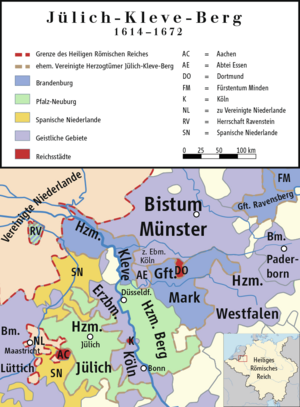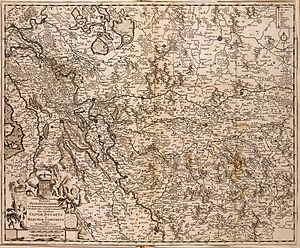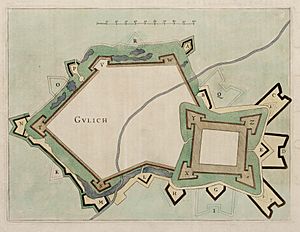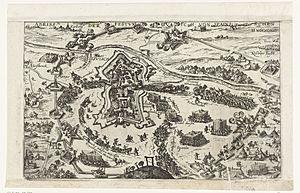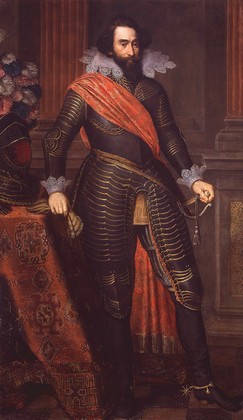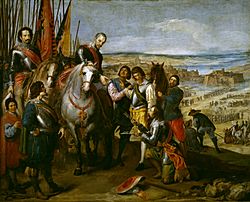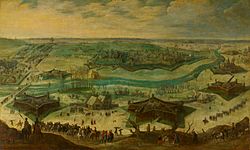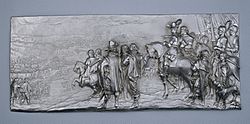Siege of Jülich (1621–1622) facts for kids
Quick facts for kids Siege of Jülich |
|||||||
|---|---|---|---|---|---|---|---|
| Part of the Eighty Years' War | |||||||
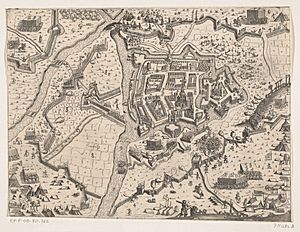 The Siege of Jülich (ca. 1622), anonymous engraving. |
|||||||
|
|||||||
| Belligerents | |||||||
| Commanders and leaders | |||||||
| Frederik Pithan Maurice of Orange |
Ambrogio Spinola Hendrik van den Bergh |
||||||
| Strength | |||||||
| 2,500-3,000 | 12,000 | ||||||
| Casualties and losses | |||||||
| Unknown | Unknown | ||||||
The Siege of Jülich was an important battle during the Eighty Years' War. This war was fought between the Dutch Republic and the Spanish Monarchy. The siege happened from September 5, 1621, to February 3, 1622.
After a 12-year break in fighting, the war started again. The Spanish army, led by Ambrogio Spinola, moved towards the Rhine river. Their real goal was to attack the town of Jülich. The Dutch States Army had taken control of Jülich in 1610. Jülich was important because it was located between the Rhine and Meuse rivers. This made it a key spot for trade and travel. Spain wanted to block these rivers to hurt the Dutch economy.
A smaller Spanish force, led by Count Hendrik van den Bergh, surrounded Jülich. The main Spanish army under Spinola stayed nearby. This was to stop the Dutch army, led by Prince Maurice of Orange, from helping Jülich. The town of Jülich had strong defenses and many soldiers. So, the Spanish decided to starve the defenders out. They also bombed the town regularly. The Dutch tried to fight back and get supplies in, but they failed. By January 1622, the Dutch soldiers were very hungry and cold. They had to give up to the Spanish. Jülich stayed under Spanish control for many years after this victory.
Contents
Why Jülich Was Important
The Eighty Years' War was a long fight for independence. The Dutch Republic wanted to be free from Spanish rule. After a major battle in 1604, the Spanish army, led by Ambrogio Spinola, started attacking the Dutch again. The Dutch had built strong forts along their rivers. These forts created good defenses. So, Spinola decided to attack areas further away, like the Rhine river region.
In 1609, both sides were tired of fighting. They signed a 12-year truce, which was a temporary peace agreement. But during this time, a problem started in the Duchy of Jülich. The Duke of Jülich died without a clear heir. This led to a fight over who would rule the area. Jülich was important because it was close to both the Dutch and Spanish lands.
In 1610, the Dutch and French armies helped one of the people claiming the land. They attacked Jülich and took control of it. Prince Maurice of Orange put a strong Dutch army there. For four years, things were quiet. But in 1614, one of the claimants to Jülich became Catholic. The Spanish army then stepped in to support him. Spinola quickly captured many towns in the area. The Dutch also sent more soldiers to protect their towns. This made the situation very tense.
By late 1620, the 12-year truce was ending. Spain and the Dutch Republic had to decide whether to keep the peace or start fighting again. Spain was already busy with another war, the Thirty Years' War. Some in Spain wanted to renew the truce. But the new Spanish king, Philip IV, wanted to continue the war. He listened to people who believed war would be better.
Spain's plan was to attack the Dutch. They wanted to take Jülich and other key forts. They also planned to block rivers to hurt the Dutch economy. The Dutch, on the other hand, focused on defense. They strengthened their forts and increased the size of their army. They believed the Spanish would attack their main river lines.
The Campaign Begins
The war officially started again on August 3, 1621. The Dutch cavalry attacked areas near Antwerp. Meanwhile, both armies gathered their forces. The Dutch army was at Schenkenschans. The Spanish army was at Maastricht. Spinola had a large force of about 15,000 foot soldiers and 4,000 horse soldiers.
Spinola wanted to trick the Dutch about his real target. Instead of going straight to Jülich, he moved his army across the Roer river. He then camped near Wesel. Maurice, the Dutch commander, moved his army to Emmerich. Heavy rains made conditions very difficult for the Dutch soldiers. Their camp flooded, and they struggled to find food for their horses. Spinola's army was on higher ground, so they were less affected.
With Jülich far away, Spinola decided to capture towns in the Cleves area. This would stop the Dutch from helping Jülich. He sent Count Van den Bergh to take Gennep. Gennep had a small Dutch army. Van den Bergh threatened to destroy the area if they didn't surrender. The town gave up. Other Spanish forces also took several smaller towns.
After securing Cleves, Spinola ordered Van den Bergh to attack Jülich. He gave him 6,000 foot soldiers, 1,000 horse soldiers, and 8 cannons. On the way, Van den Bergh also captured the castle of Rheydt. This castle was defended by 150 Dutch soldiers. The castle's owner was forced to tell the Dutch commander to surrender. The Dutch soldiers were allowed to leave with their weapons. But their commander was later put on trial by the Dutch army and sentenced to death for surrendering.
Life During the Siege
The Spanish army reached Jülich on September 4. They took many animals and crops from around the town. The Dutch governor of Jülich, Frederik Pithan, had refused to bring the crops inside the city. He had orders not to bother the local people too much. On September 5, the Spanish began to surround Jülich. They even changed the course of the Roer river. This dried up the moats around the city walls.
Jülich was a small but very strong town. Its defenses were built in the mid-1500s. It had a large citadel with four strong points called bastions. The town walls were also very strong. When it was finished in 1580, it was one of the strongest forts in Europe. The Dutch had added even more defenses after they captured it in 1610. The Dutch army in Jülich had about 2,500 to 3,000 soldiers. Their commander was 72-year-old Frederik Pithan. The fort had plenty of supplies, but not enough money to pay the soldiers.
Since Jülich's defenses were so strong, Spinola decided not to attack directly. Instead, he planned to starve the town into surrender. He ordered Van den Bergh to build a line of forts and trenches around Jülich. This would completely cut off the town. Pithan, the Dutch commander, ordered several attacks on the Spanish lines. They burned the town's mills to stop the Spanish from using them. They also attacked the Spanish camp, causing some Spanish deaths. But these attacks did not achieve much.
As the siege continued, the weather got worse. Constant rains turned the ground into deep mud. Rivers overflowed, making it hard to get supplies to the Dutch army outside Jülich. As winter arrived, soldiers on both sides got sick. Many Dutch soldiers left the army. Maurice, the Dutch leader, tried to send troops to help Jülich. He planned to sneak soldiers up the Meuse river. But Spinola found out about the plan. He sent his army to block the Dutch relief force. When the Dutch realized they were expected, they turned back.
In December, the Dutch army left the area for winter. But the Spanish army stayed around Jülich despite the cold. Spinola ordered heavy bombing of the town day and night. Food became very scarce inside Jülich. The soldiers were put on strict rations. Officers ate horse meat, but regular soldiers had to eat dog, cat, and even rat meat. Firewood was also very hard to find. The soldiers suffered greatly from the bitter cold.
By January 17, Pithan started talking about surrendering. He sent three captains to the Spanish camp. They agreed on terms on January 20. The Dutch would surrender on February 3 if no help arrived. The Spanish agreed to let the Protestant religion continue in Jülich. They also allowed the Dutch soldiers to leave with their weapons and belongings. They would be escorted safely to Nijmegen. Pithan agreed to hand over all ammunition and official papers.
On February 3, the remaining 2,000 Dutch soldiers left Jülich. They marched out with their flags folded. Pithan handed the keys of the city and the citadel to Count Van den Bergh. The Spanish army then took control of the town. They found 36 cannons and a lot of gunpowder.
What Happened Next
After taking Jülich, the Spanish army secured the rest of the area. The Spanish victory at Jülich was very important. It showed that Spain was still a strong military power. The Dutch were very sad to lose Jülich. They had spent a lot of money to keep its defenses strong.
In 1622, Spinola attacked another Dutch town called Bergen op Zoom. The Spanish also wanted to control the Rhine river. This was important for stopping trade between the Dutch and German states. So, a large Spanish force attacked another Dutch fort called Pfaffenmütze. After five months of bombing, the Dutch soldiers there also surrendered.
Over the next few years, Spain increased its pressure on the Dutch economy. They wanted to damage Dutch trade. This trade relied on rivers to move goods. By 1625, a full blockade was in place. This caused the price of many Dutch products to drop. It also made the cost of shipbuilding materials go up. But the blockade also caused problems for Spain. So, it was lifted in 1629. Jülich stayed under Spanish control until 1660.
Remembering the Siege
The Siege of Jülich was Spain's first big win after the truce. Because of this, the Spanish king ordered a painting to celebrate it. The painting, called The Surrender of Jülich, was made by Jusepe Leonardo in 1634. It shows Ambrogio Spinola receiving the keys to Jülich from the Dutch commander. The town and the leaving Dutch soldiers are in the background.
Another painting of the siege was made by the Flemish artist Sebastian Vrancx. It shows a realistic view of the siege in winter. The landscape is covered in snow, and the Roer river is frozen. Spanish forts and houses are in the front. The town of Jülich is shown accurately.
The Spinola family also commissioned artworks to celebrate Ambrogio's victories. They had frescos painted in their summer home. One of these shows the surrender of Jülich. They also had silver reliefs made for a cabinet, one of which also shows the surrender.
The Siege of Jülich was also reported in early newspapers. Abraham Verhoeven, a newspaper editor, published news about Spinola's campaigns. He likely got support from Spinola himself. A Dutch journalist, Nicolas van Geelkercken, also wrote detailed reports about the siege. He praised Maurice of Nassau in his writings.
Images for kids
See also
 In Spanish: Asedio de Jülich (1621-22) para niños
In Spanish: Asedio de Jülich (1621-22) para niños


